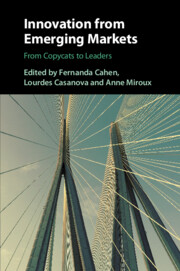Book contents
- Innovation from Emerging Markets
- Innovation from Emerging Markets
- Copyright page
- Contents
- Figures
- Tables
- Boxes
- Contributors
- Foreword
- Acknowledgments
- Introduction
- 1 A Framework for Innovation in Emerging Markets
- Part I Drivers of Innovation in Emerging Markets
- 2 The Breadth and Extent of Chinese Innovation as Documented in the 2017 Corporate Innovation Survey
- 3 The Rise of an Innovation Tiger
- 4 Exploring the Role of Government Involvement in Innovation
- 5 Digital Companies Driving Business Model Innovation in Emerging Markets
- 6 Entrepreneurial Ecosystems and Innovation in the Balkans
- Part II Types of Innovation in Emerging Markets
- Part III Innovation Outcomes in Emerging Markets
- Conclusions
- Index
- References
2 - The Breadth and Extent of Chinese Innovation as Documented in the 2017 Corporate Innovation Survey
from Part I - Drivers of Innovation in Emerging Markets
Published online by Cambridge University Press: 15 March 2021
- Innovation from Emerging Markets
- Innovation from Emerging Markets
- Copyright page
- Contents
- Figures
- Tables
- Boxes
- Contributors
- Foreword
- Acknowledgments
- Introduction
- 1 A Framework for Innovation in Emerging Markets
- Part I Drivers of Innovation in Emerging Markets
- 2 The Breadth and Extent of Chinese Innovation as Documented in the 2017 Corporate Innovation Survey
- 3 The Rise of an Innovation Tiger
- 4 Exploring the Role of Government Involvement in Innovation
- 5 Digital Companies Driving Business Model Innovation in Emerging Markets
- 6 Entrepreneurial Ecosystems and Innovation in the Balkans
- Part II Types of Innovation in Emerging Markets
- Part III Innovation Outcomes in Emerging Markets
- Conclusions
- Index
- References
Summary
This chapter catalogs the characteristics of Chinese corporate innovation activities based on data from the Chinese corporate innovation survey. Innovation fueled China's economic development and social welfare promotion, and resulted in the country offering high-quality products and services to the world’s consumer market. Chinese enterprises value innovation, especially those in the high-tech manufacturing and the software and information technology service industries. However, collaborations with universities and institutes are still rare, and occur even less frequently with overseas companies and institutes. As China's innovation capability improves, the country will not only represent the largest market for the commercialization of global innovation, but also become an increasingly important member of the international research and development (R&D) network.
- Type
- Chapter
- Information
- Innovation from Emerging MarketsFrom Copycats to Leaders, pp. 39 - 62Publisher: Cambridge University PressPrint publication year: 2021



